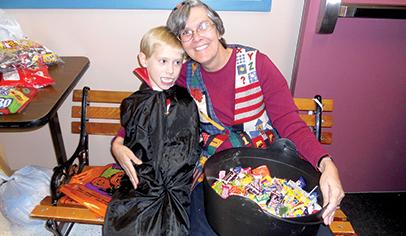A Halloween Event That's a Real Treat

Students who otherwise wouldn’t be able to celebrate Halloween can do so safely at this school-based event.
When a child grows up in a rural town, with acres of land stretching between homes, it’s hard to experience traditional Halloween trick-or-treating and neighborhood camaraderie. But the parent volunteers at Peyton (Colo.) Elementary are determined to give students a true Halloween experience.
Each year, the Peyton Elementary Parents group hosts a Trick-or-Treat Street and fall carnival at the school that combines door-to-door trick-or-treating with games, raffles, musical cakes, face-painting, and plenty of refreshments.
The town of Peyton, located near Colorado Springs, has a population of 250. Peyton Elementary serves the town as well as the surrounding area, a large rural community. Some of the bus rides are 40 minutes each way to bring students to and from school.
The Halloween festivities are a highlight of the school year. “It is absolutely a tradition,” says PEP president Jenni Esser. “The kids are so excited to get dressed up and see all their friends.”
The celebration is really two events rolled into one. Trick-or-treating is held in the school’s main hallway; that leads to the gym, where the fall carnival is located. Both events run at the same time, from 5 p.m. to 7 p.m. on either Halloween night itself or the weeknight closest to it. Concession stands and a chili cook-off are set up in the cafeteria. Families can choose which event to visit first, and as a result there’s never been a traffic jam on Trick-or-Treat Street, Esser says.
Attendees contribute small bags of candy as admission, which are given to the trick-or-treaters. PEP members bring the “starter candy” for the early arrivals. The hallway is transformed with spooky decorations and dimmed ceiling lights. Strings of small colored lights are placed along the floor. Volunteers set up desks in the hallway, about a dozen in all, as candy stations. Costumed children stop at each desk along the hallway and ask for a treat.
The candy stations are manned by National Honor Society volunteers from the local junior and senior high schools. At least one adult volunteer stays on the “street” to make sure that younger children aren’t spooked and that the traffic flows smoothly.
The carnival has traditional activities and events like musical cakes, mini golf, a costume contest, and games of chance. The PEP uses a ticket system for all activities, with five tickets costing $1; attendees can also trade 10 box tops for five tickets. Tickets are used for voting in the chili contest and costume contest, and for the carnival “jail”: Attendees can use tickets to put someone in jail as well as bail someone out.
Last year, Esser added new options for teachers. They can sponsor an activity booth, such as mini golf or lasso the hat, by manning it throughout the carnival. (They can use their own volunteers to help.) Then, the proceeds from that booth go directly to that teacher for classroom purchases.
So far, the Halloween celebration has been self-funding, with plenty left over to donate to the National Honor Society’s annual Veterans Breakfast in December. In 2013, for example, the PEP made about $700, deducted $200 to pay for prizes and other miscellaneous items, and donated the remaining $500.
With each passing year, this special Halloween night becomes more and more anticipated and enjoyed, Esser says. Parents appreciate that their kids get a genuine Halloween in a safe environment.
“Just watching the kids running around is great,” she says. “Even the older kids love doing Trick-or-Treat Street.”
Peyton Elementary PEP
Peyton, Colo.
300 students, grades K-6
A Trick-or-Treat Timeline
August
- Reserve building.
- Finalize draft of flyer and booths.
- Compile list of needed supplies, prizes, and concessions.
September
- Approve flyer and booth options and finalize budget for prizes at meeting.
- Order prizes.
- Request tables and other help needed from maintenance staff.
- Invite teachers to sign up to run a booth.
- Invite parents to staff a booth for a shift.
- Sign up junior high and high school volunteers.
- Put together directions for setting up and running booths.
October
- First week of month: Distribute flyers to go home with students.
- Week of event: Get supplies from storage.
- End of month: Send email reminder with flyer attached.






















